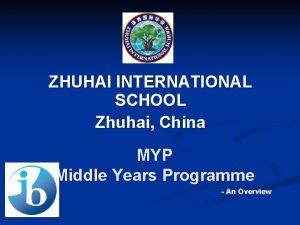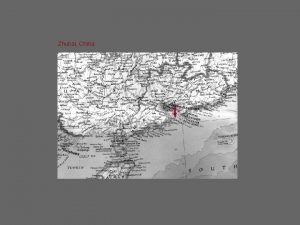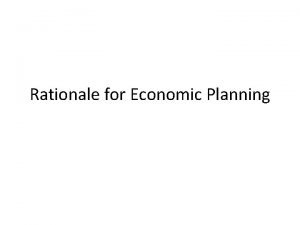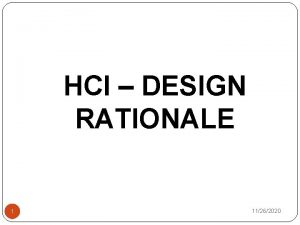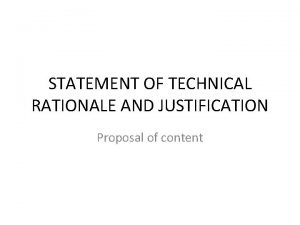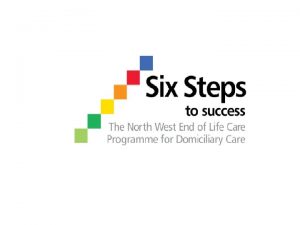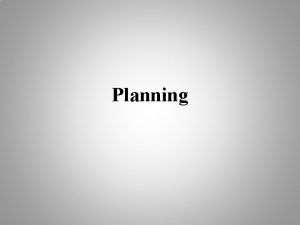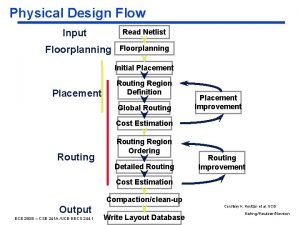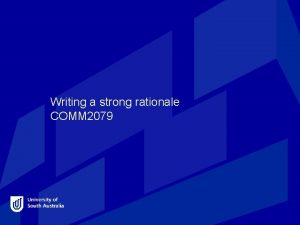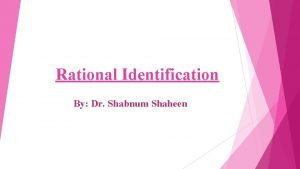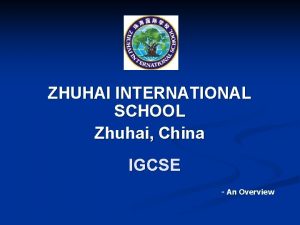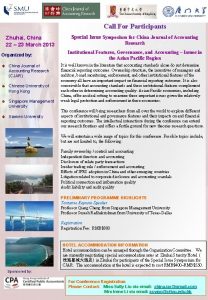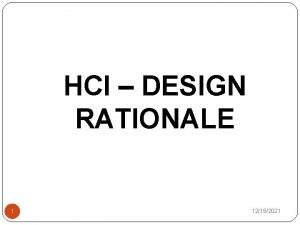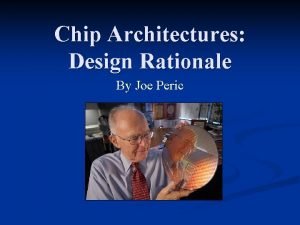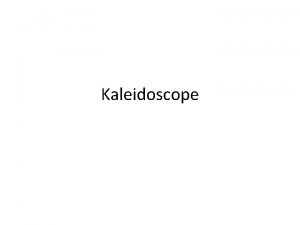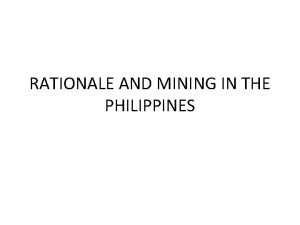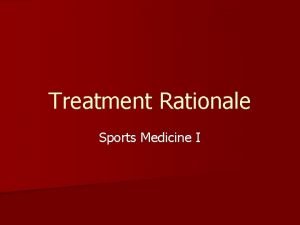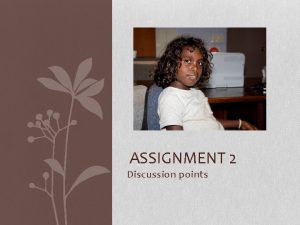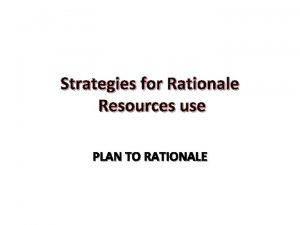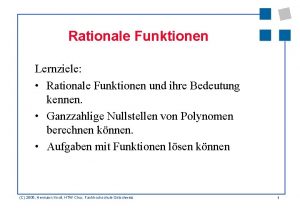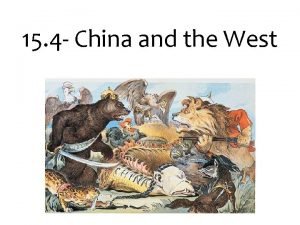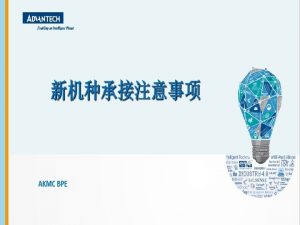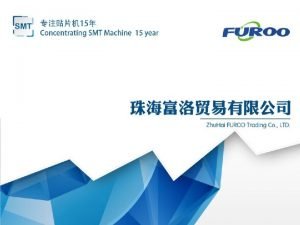Zhuhai China Planning and Design Rationale Design Concept





















- Slides: 21

Zhuhai, China













Planning and Design Rationale Design Concept • The concept consists of a complex of three distinct yet richly connected buildings that relate clearly to their natural and built context. • In this design, the natural harmony of the original land form is restored, while at the same time, currently existing grades are used wherever possible to minimize earthworks. Grade changes play an important role in shaping and defining the architectural concept. • In the Site Plan, each of the buildings has a somewhat different orientation. The southernmost building, the administration block, is oriented to the road and lake to the south. The middle building, the classroom block, is aligned to the road to the east, and the northernmost building, the laboratory block, is aligned to the slope of the mountain. • The laboratory portion of the laboratory building nestles into the natural hillside in the north east portion of the site, sitting above, and thus sheltering the entry porch and informal outdoor gathering deck of the laboratory/ classroom combination. This hovering mass, with its crowning skylight and thermal chimney, provides a strong visual focus and iconic presence for the site.

Planning and Design Rationale Design Concept • The main entry to the complex as a whole is provided by a 2 ½ storey glass atrium with its glass roof sloped to reveal this focus. The visual and movement axis of the atrium is directly aligned with the centre (conical skylight) of the laboratory building set into its verdant mountainside setting– a powerful image of the interplay of man-made object and nature symbolic of the character of the campus as a whole. • The main entry atrium thus provides a visual orientation to the complex, offers access to every part of the complex, and provides a bright and lofty meeting and gathering place for students, staff and visitors. • Meeting and gathering places, both indoor and outdoor, are placed in strategic locations throughout the complex to facilitate and encourage social contact and communication. • The green roof of the classroom block provides a garden roof terrace , overlooking the new lake which has been created in the western portion of the site, and itself overlooked by the laboratory block and upper floor offices. This roof garden is accessible directly via stairs from the central plaza or a bridge from the office block.

Planning and Design Rationale Movement / Connections • Pedestrians There are 4 pedestrian pathways traversing the site from south to north and connecting all of the buildings and outdoor spaces. These are shown and described on the “Movement” Plan. • Vehicles Service and private vehicles share the road on the east side of the site. Service vehicles proceed to a service dock at the rear of the Laboratory block. Short term parking spaces are provided off of the Central Square. At this stage, no underground parking has been shown.

Planning and Design Rationale Architectural Style • At Zhuhai we have the benefit of starting fresh, without the stylistic constraints of an older campus where a “traditional” or historic style may already have been established. It makes sense for the architecture here to express the present, and the future, and to have the simplicity, strength and unity of form to enhance and emphasize the natural environment of greenery, mountains and lakes at Zhuhai. This new tradition has already begun to take root at Zhuhai with the Library, Teaching Buildings, and recently completed Media Design School. The Administration Complex is meant to continue and emphasize this direction. • Simple, elemental, strong forms provide a sense of power that is appropriate to the importance of this building on the campus. • Other forms are used for their symbolic significance. For example, as well as serving the important function of providing natural light and enhancing energy efficiency, the conical form of the laboratory block skylight and thermal chimney provides a symbolic presence, enhancing and dramatizing the experience of entering the main atrium, while at the same echoing the form of the Phoenix Mount in its backdrop. • The architecture also embraces a vocabulary which expresses the implementation of devices that enhance sustainability and energy efficiency. The conical skylight and thermal chimney referred to above is an example of this. Louvers used to shade south-facing glass is another (see Street Elevation).

Planning and Design Rationale Architectural Style

Planning and Design Rationale Energy-saving and Virescence “Green buildings are far superior to their conventional counterparts, typically including features such as: • • Siting to minimise stress on natural systems… Durable, thermally efficient roofs, walls and windows that reduce heating and cooling and enhance thermal comfort. Building form, orientation and thermal mass optimized for … natural ventilation and daylighting… Significantly smaller and more efficient HVAC and electrical lighting systems. Water efficient supply and waste fixtures. Adaptable interior designs, providing visual access to the outdoors and access to daylight. Interior finishes and installation methods having lower toxic emissions. Landscaping that requires little or no irrigation or application of synthetic chemicals, manages and treats stormwater and non-point-of-source pollution on site, and replenishes groundwater supplies, …” Canadian Green Building Council LEED Green Building Rating System Reference Package

Planning and Design Rationale Energy-saving and Virescence • This passage from the Canadian LEED manual summarizes the characteristics of Sustainable Building Design. Though many of these involve details that are beyond the scope of this presentation, and which may be considered at a more detailed design stage, those that may be shown at this stage of the design include: • • Building siting and planning to minimize west facing glass Use of special low-e glass for hot climates (the best of this type of glass has a green tint as indicated on the Elevation drawing). Use of horizontal louvers to shade south-facing glass. Skylights or, in the case of the upper floor offices in the administrative block, a clerestory roof monitor window to provide natural light into “deep” interior spaces. Green roofs to provide superior insulation, aid in tempering storm water runoff, and at the same time provide useful roof gardens. Thermal chimneys for natural ventilation to augment mechanical air conditioning systems. • •

Planning and Design Rationale Energy-saving and Virescence At York University in Toronto louvers shading south-facing glass provide a distinctive and attractive architectural effect.
 International school zhuhai
International school zhuhai Design concept rationale
Design concept rationale Rationale for economic planning
Rationale for economic planning Design rationale in hci
Design rationale in hci Research problem statement and objectives examples
Research problem statement and objectives examples Justification and rationale
Justification and rationale Background and rationale
Background and rationale N planning
N planning Long medium and short term planning in primary schools
Long medium and short term planning in primary schools Language policy and planning ppt
Language policy and planning ppt Describe your ideal self example
Describe your ideal self example Pengertian pemasaran
Pengertian pemasaran Aperture concept in media planning
Aperture concept in media planning Aperture concept in media planning
Aperture concept in media planning Concept plan definition
Concept plan definition Manpower planning types
Manpower planning types Region definition
Region definition Floor planning concept in vlsi ppt
Floor planning concept in vlsi ppt Social demand approach to educational planning
Social demand approach to educational planning Media rationale example
Media rationale example Nursing diagnosis three parts
Nursing diagnosis three parts Rationale of a project
Rationale of a project
